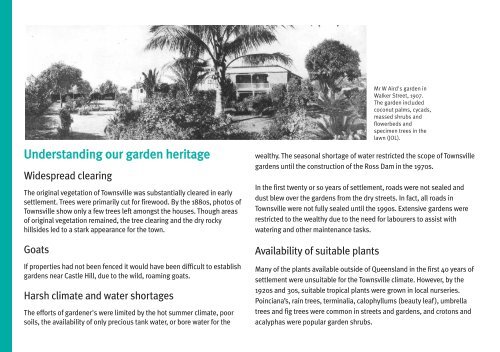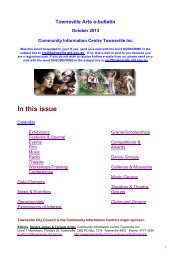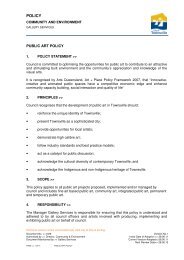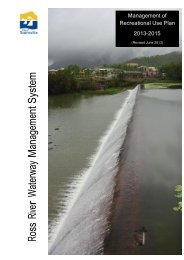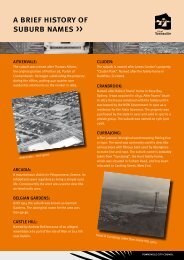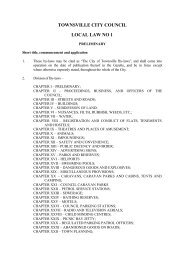Heritage and Character Housing - Townsville City Council
Heritage and Character Housing - Townsville City Council
Heritage and Character Housing - Townsville City Council
- No tags were found...
You also want an ePaper? Increase the reach of your titles
YUMPU automatically turns print PDFs into web optimized ePapers that Google loves.
Underst<strong>and</strong>ing our garden heritageWidespread clearingThe original vegetation of <strong>Townsville</strong> was substantially cleared in earlysettlement. Trees were primarily cut for firewood. By the 1880s, photos of<strong>Townsville</strong> show only a few trees left amongst the houses. Though areasof original vegetation remained, the tree clearing <strong>and</strong> the dry rockyhillsides led to a stark appearance for the town.GoatsIf properties had not been fenced it would have been difficult to establishgardens near Castle Hill, due to the wild, roaming goats.Harsh climate <strong>and</strong> water shortagesThe efforts of gardener's were limited by the hot summer climate, poorsoils, the availability of only precious tank water, or bore water for thewealthy. The seasonal shortage of water restricted the scope of <strong>Townsville</strong>gardens until the construction of the Ross Dam in the 1970s.In the first twenty or so years of settlement, roads were not sealed <strong>and</strong>dust blew over the gardens from the dry streets. In fact, all roads in<strong>Townsville</strong> were not fully sealed until the 1990s. Extensive gardens wererestricted to the wealthy due to the need for labourers to assist withwatering <strong>and</strong> other maintenance tasks.Availability of suitable plantsMr W Aird's garden inWalker Street, 1907.The garden includedcoconut palms, cycads,massed shrubs <strong>and</strong>flowerbeds <strong>and</strong>specimen trees in thelawn (JOL).Many of the plants available outside of Queensl<strong>and</strong> in the first 40 years ofsettlement were unsuitable for the <strong>Townsville</strong> climate. However, by the1920s <strong>and</strong> 30s, suitable tropical plants were grown in local nurseries.Poinciana’s, rain trees, terminalia, calophyllums (beauty leaf), umbrellatrees <strong>and</strong> fig trees were common in streets <strong>and</strong> gardens, <strong>and</strong> crotons <strong>and</strong>acalyphas were popular garden shrubs.


